The strength and durability of concrete makes it an important structural material. However, concrete’s porous nature allows it to absorb water and soluble salts, which can be destructive. Further, when steel reinforcement is embedded in concrete to increase its strength, concrete’s absorption of salts, particularly chlorides, will eventually cause corrosion issues. Therefore, the protection of concrete from environmental factors may be critical to preserving its function over time. Applying concrete sealers over new or existing concrete surfaces is a typical solution.
Concrete sealers perform as water repellents—preventing water and chlorides from penetrating the concrete.
Applied to concrete, sealers essentially perform as water repellents, eliminating or reducing the penetration of water and soluble contaminants, such as chlorides, into the porous concrete layer. Sealers are generally intended for use in above-grade applications where concrete is frequently exposed to moisture. Good examples of areas with sealed concrete are parking decks or other exterior concrete surfaces where thicker film coatings are not desired. Other typical concrete surfaces that are sealed include block and masonry walls.
Sealers consist of a variety of types, but silicon-based materials are most frequently used. Other sealer types include linseed oil solutions (diluted with solvents), as well as acrylic, epoxy, and polyurethane materials.
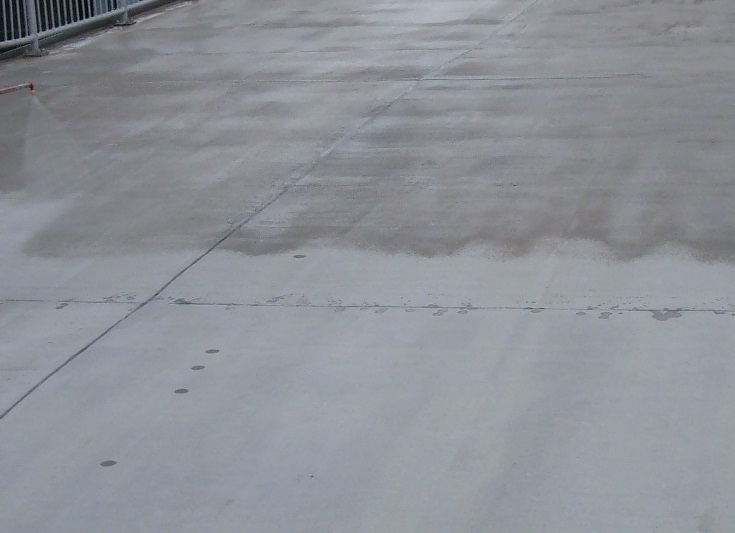
Typically, thin-film concrete sealers are specified on above-grade projects where thick-film coatings would not be appropriate.
Generally, sealers function by reacting with the components of the inorganic concrete to fill pores, making it difficult for water to penetrate the surface. Although sealers will not keep pressure-driven water from penetrating the concrete, any water that is absorbed can evaporate since sealer materials are permeable to water vapor – i.e. they are breathable. Sealers can be expected to last up to several years depending on the concrete surface, specific repellent properties, and service environment.
Sealers are low-viscosity materials that can be water- or solvent-based. They are typically applied by low-pressure spray to concrete surfaces and may require back rolling. Typical sealers provide protection by penetrating the pores of the concrete, leaving little measurable film on the surface. Because of this, a common problem is light coverage and proper application can be difficult to judge because of the thin viscosity.
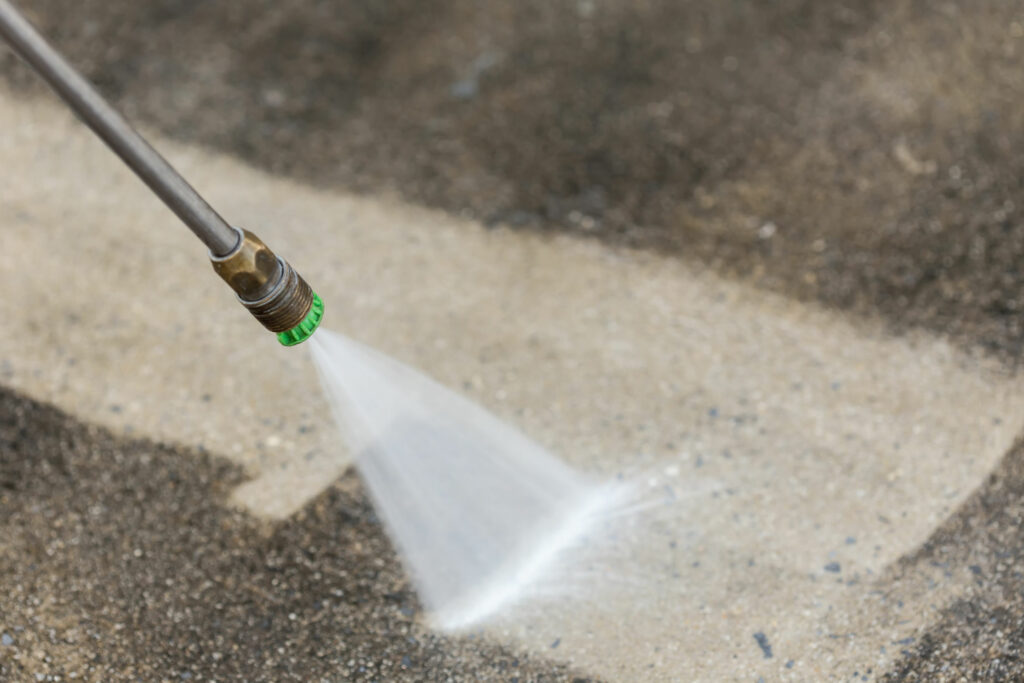
Typical surface preparation methods include pressurized water cleaning with or without detergents.
Silicon-based compounds are among the most common repellents since they resist oxidation and offer good thermal stability and heat resistance, as compared to typical organic compounds. They also have good resistance to ultraviolet radiation (sunlight) and water, making them ideal water-repellent materials. The hydrophobic nature of the silicon-based material repels water from the concrete surface causing water droplets to bead. Silicon-based sealers include silanes, siloxanes, and silicates. While silanes and siloxanes function by penetrating the concrete and filling pores, silicates function in a different manner. These materials react with the calcium hydroxide in the concrete and essentially block, rather than fill, the pores. Some silicate sealer products are also called densifiers since they “harden” the top surface. These densifying products are typically used for polished concrete surfaces.
Other “sealer” products that are based on organic resins, such as acrylics, epoxies, or polyurethanes, may penetrate concrete surfaces to a slight degree, but are likely materials that also form a thin film on the surface. These types of sealer products generally will not be as breathable as silicon-based sealers. There also are hybrid sealers, typically based on silanes or siloxanes that incorporate organic resins such as acrylics.
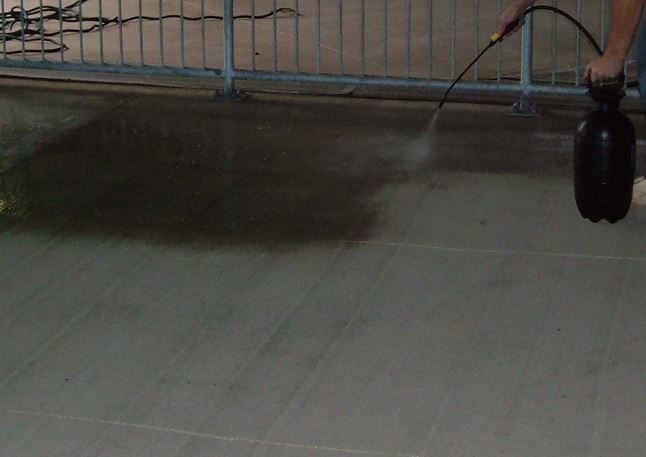
The sealers can be water- or solvent-based and are typically applied to concrete via low-pressure sprayer
Selecting Concrete Sealers
A comparison of different types of sealers is presented in Table 1. The amount of material that should be applied is based on the coverage rate for a particular product, although this will vary based on the characteristics of the concrete. For example, the type of finish or surface roughness, whether new or existing, and overall condition, are key factors that will affect coverage rates for a product. Generally, one or two coats are required, which again is dependent on the condition of the concrete and specific product. The coverage rate for a second coat is expected to be greater than for the first, even if rates for each coat are not published for a product.
Types of Sealers
| Sealer Type | Coverage Rate | Coats |
| Acrylic | 150-300 | 1 or 2 coats |
| Epoxy | 200-500 | 2 coats |
| Linseed Oil | 300-400 | 2 coats |
| Polyurethane | 250-400 | 1 or 2 coats |
| Silane | 150-300j | 1 or 2 coats |
| Siloxane | 100-250 | 1 or 2 coats |
| Silicate | 400-800 | 1 or 2 coats |
The durability of different sealer types varies widely–from as short as one year to several years. Linseed oil materials will typically have the shortest service life and silane or siloxane materials the longest. Sealers need to be periodically reapplied depending on the service environment.

Surface Prep
The surface preparation requirements for sealers basically consist of assuring clean and sound concrete. The surface does not need to be appreciably roughened since the sealer absorbs into the concrete rather than adheres to the outer surface. However, for sealers to function as intended, a clean surface is critical. For example, grease or oil on the surface will prevent the repellent from absorbing into the concrete.
Preparing existing concrete may also include repairing any cracks, spalls, and voids with an appropriate concrete repair material. The repair materials must be intended for use with concrete and appropriate for the service environment. Any efflorescence that has formed must also be removed. Efflorescence occurs when moisture travels through concrete dissolving soluble salts, and then dissipates leaving the salt residue on the concrete surface. It is a surface contaminant that needs to be removed. The residue can be removed by washing the surface.
Silicon-based sealers include a variety of silanes, siloxanes, and silicates.
Typical surface preparation methods include pressurized water cleaning and mechanical abrasion. As stated earlier, since sealers function by absorbing into the concrete without building any significant film, roughening the surface is not necessary. This makes pressurized water cleaning a typical choice for preparation. It is also possible to use cleaning solutions containing detergents that are recommended for cleaning concrete. It is vital that any cleaning materials be compatible with the intended sealer.
Although mechanical abrasion methods and blast cleaning should not be necessary for sealer application, they can be performed in order to roughen the surface to increase slip resistance before the sealer is applied. It might also be used to remove an existing coating. Mechanical abrasion methods for concrete include blast cleaning, which can be accomplished if proper care is exercised. The goal is to roughen the surface without causing damage or gouging that might require repairs. Lower blast pressures and a greater stand-off distance may be needed with blast cleaning. An alternative to traditional blast cleaning is wet abrasive blasting, which includes two variations: injection of water into the air stream propelling abrasive (similar to dry abrasive blasting) or injection of abrasive into a water stream propelling abrasive (similar to pressurized water cleaning).
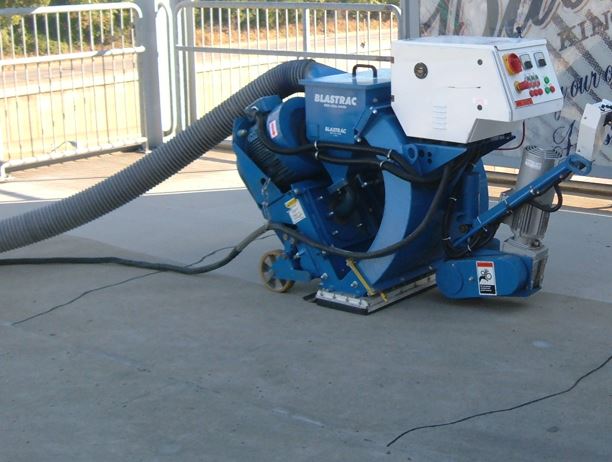
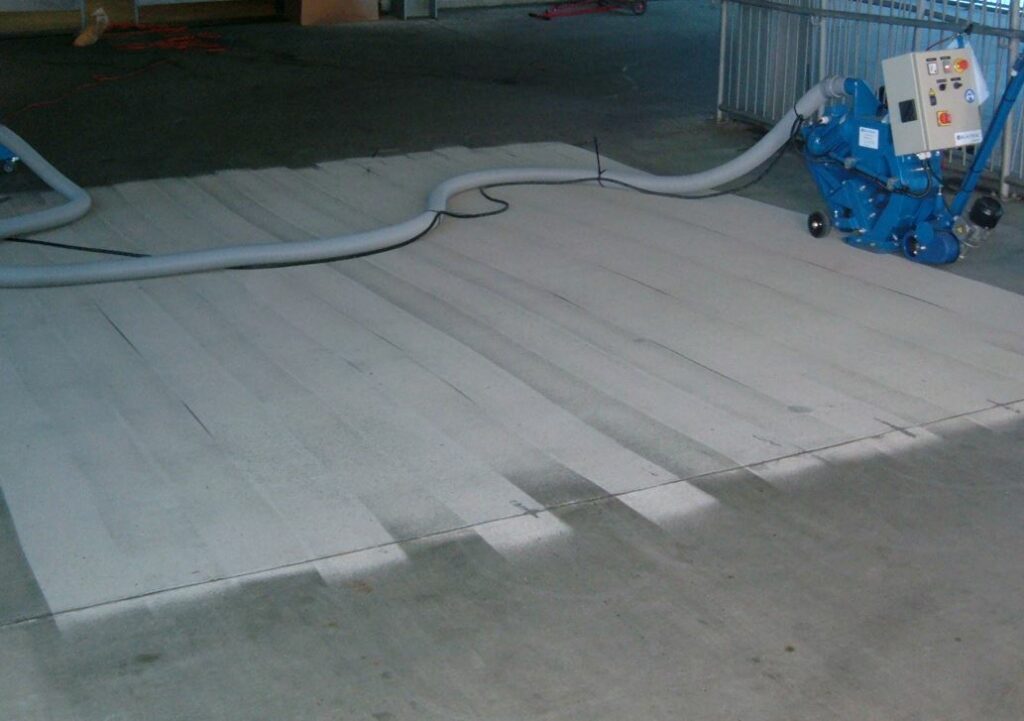
Although mechanical abrasion isn’t usually necessary when applying sealers, it can be utilized to increase slip resistance. Photo courtesy of KTA-Tator, Inc.
Blast cleaning may also be performed using self-contained centrifugal wheel blast units that feature a vacuum system to contain the abrasive and debris. These units are well-suited to large horizontal surface areas, such as concrete floors and parking decks. Power tools, with or without vacuum shrouding, are also an option for preparing smaller areas.
The successful application of sealers will prevent water, soluble salts, and other contaminants from absorbing into porous concrete and will extend its service life.
Sealers will also provide some protection from destructive freeze/thaw cycles in exterior environments as well as protection for embedded reinforcing steel. The application of sealers, when concrete is new, is typically the best approach to provide maximum protection and prevent contamination of the concrete from environmental elements.




Gary, thank you for your comment! We’re glad the article could provide some guidance.
Good article – thanks for sharing it
Thanks Michael, glad you enjoyed it.
KTA’s article on the importance of concrete sealers provides valuable insights into the critical role sealers play in maintaining and extending the lifespan of concrete structures. The article discusses the various benefits of using sealers, such as protection against water infiltration, chemical resistance, and durability enhancement. It’s a must-read for professionals and enthusiasts alike, offering essential knowledge on preserving concrete surfaces effectively and ensuring their longevity.
Thank you for reading!